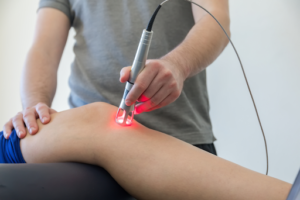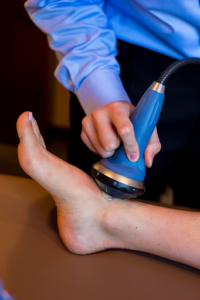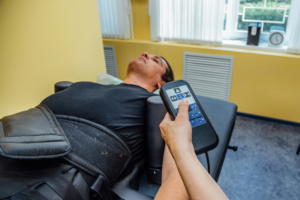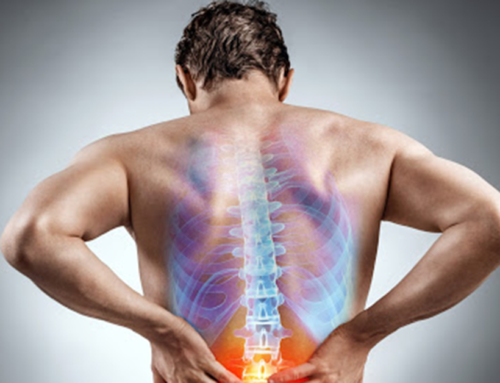We hear on the news every day about the millions of Americans who have found themselves addicted to opioids. Many of these people began taking them to relieve pain after an injury or surgery, never expecting that they’d end up battling addiction. Even non-narcotic pain medications can cause serious side effects, including kidney damage and stomach bleeding, if used frequently or in high doses.
Being in pain can negatively affect your ability to work and go about your daily life, so if pills aren’t a good long term option and you want to avoid surgery, what can you do? Luckily there are several clinically proven treatments for pain that don’t involve drugs or invasive procedures.
In this article, we are going to take an in-depth look at laser therapy, acoustic compression, and spinal decompression. Each of these therapies has been clinically proven to reduce pain and speed healing.
Laser Therapy
Laser therapy is an FDA approved treatment that improves your body’s ability to heal itself. There are different kinds of lasers used to heal injuries and reduce pain. Class IV lasers are the most effective kind and are becoming the gold standard of the practice. Using this laser, a clinician can direct a beam of concentrated red light into the injured or painful area. This light causes a reaction on the cellular level, increasing the rate of nutrient transfer between cells. In more simple terms, it speeds up circulation, reduces inflammation, helps to bring nutrients to the affected area, and accelerates the healing process.
The process of laser therapy is gentle and non-invasive. A clinician will shine the laser onto your bare skin over the injured area. Most patients don’t feel anything, and some people report feeling a soothing warmth during treatment. Laser therapy sessions usually take between three and nine minutes, and multiple sessions are required for permanent pain reduction. The only reported side effect of laser therapy is increased sensitivity in the treated area for a few days after treatment. This occurs because the body is speeding healing in that area.
Laser Therapy has been proven effective for a broad range of conditions. Patients with injuries to tendons and ligaments, repetitive stress injuries and back and neck pain are excellent candidates for laser therapy. It has also been used effectively for rheumatoid arthritis pain, diabetic neuropathy, and to heal injuries such as burns.
Laser therapy should not be used on pregnant women. It is safe for most people, but your chiropractor or physical therapist should ask you about tattoos or metal implants near the site of treatment and about medications you are taking.
Acoustic Compression Therapy
The science behind this therapy is the same as is used in lithotripsy- a treatment that uses sound waves to break up kidney stones. Acoustic Compression Therapy (ACT) is sometimes explained as being similar to an ultrasound. This is true in the sense that both treatments utilize sound waves, but the sound waves used in ACT are 1000x more concentrated than in a regular ultrasound. The sound waves actually create physical pressure in the area.
Imagine if you were able to get a massage on the deepest levels of your tissue. That is what ACT is like. The concentrated sound waves work to break up scar tissue, increase circulation, and promote healing. The sound waves also fight pain by stimulating the nerves in the injured area, causing their pain signaling activity to diminish.
ACT is performed in a similar way to an ultrasound. A gel is applied to the treatment area, and the FDA approved ACT device is used to send sound waves deep into the tissue. Your feedback will determine precisely how the treatment goes. The clinician can vary the intensity and penetration depth of the soundwaves to treat your specific injury. You may feel an ache in the area during treatment, but it should never become severely painful. Your clinician will ask you how you are feeling and can change intensity accordingly.
The average treatment takes twenty to thirty minutes to perform, and most patients will see measurable results right away. The only side effects are redness on the skin and tenderness in the area that may last for a few days. Most patients can achieve their goal in five to seven treatments.
ACT can be used on many of the same types of injuries as Laser Therapy, including soft tissue injuries, back, and neck pain, and sports injuries. If you have one of these conditions, you will need to talk to your chiropractor or physical therapist to see which treatment is right for you. ACT should not be used on pregnant women.
Spinal Decompression
Back and neck pain are often caused by problems with spinal discs. The discs are the cushions between your vertebrae that act as shock absorbers and allow your spine to be flexible. If you are suffering from back or neck pain, worn or herniated discs may be to blame. These discs become worn as you age, but can also be ruptured or start to bulge as a result of traumatic injuries, such as a car accident. Spinal decompression can alleviate disc-related pain and aid in the healing process.
Spinal Decompression is a form of motorized traction that gently stretches your spine. This stretching creates negative pressure between the vertebrae that can pull bulging discs back into place. This treatment literally takes the pressure off of your nerves, resulting in pain relief. It has the added benefit of encouraging the movement of fluids and nutrients around your discs, promoting your body’s natural healing processes. Your clinician can control the treatment as it’s happening to personalize it to your unique needs.
Spinal Decompression treatment is comfortable and noninvasive. Most sessions last about thirty minutes, and the typical protocol involves between twelve and twenty treatments administered over a four to six week period. Most patients see measurable relief within the first few weeks of treatment, and significant relief after the protocol is complete.
Spinal decompression is appropriate for most patients but is not recommended for pregnant women, patients with screws, or other metal implants in their back or people with certain cancers. Many people with back and neck injuries use spinal decompression in conjunction with other treatments such as laser therapy or ACT.







